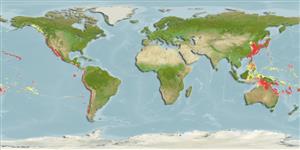分類 / Names
俗名 | 同種異名 | Catalog of Fishes (gen., sp.) | ITIS | CoL | WoRMS | Cloffa
Actinopterygii
輻鰭魚綱 (條鰭魚) >
Perciformes (Perch-likes) >
Scombridae (Mackerels, tunas, bonitos) > Scombrinae
Etymology: Scomber: Greek, skombros = tunny or mackerel, 1623 (Ref. 45335); japonicus: Named after Japan, its type locality (Ref. 6885).
環境 / 氣候 / 範圍
生態學
; 海洋; 海洋洄游的 (Ref. 51243); 深度上下限 0 - 300 m (Ref. 168), usually 50 - 200 m (Ref. 35185). 10°C - 27°C (Ref. 35185), preferred 25°C (Ref. 107945); 60°N - 48°S, 116°E - 70°W
Indo-Pacific: anti-tropical, absent from the Indian Ocean except for South Africa, KZN to Western Cape (58304).
Reports from Atlantic incl. Mediterranean are Scomber colias, and from Red Sea and northern Indian Ocean are Scomber australasicus (Ref. 27328).
Length at first maturity / 大小 / 重量 / 年齡
Maturity: Lm 26.1 range ? - ? cm
Max length : 64.0 cm TL 雄魚/尚未辨別雌雄; (Ref. 9015); common length : 30.0 cm FL 雄魚/尚未辨別雌雄; (Ref. 168); 最大體重: 2.9 kg (Ref. 26550); 最大年齡: 18 年 (Ref. 35185)
背棘 (總數): 9 - 11; 背的軟條 (總數): 112; 臀棘 1; 臀鰭軟條: 12 - 14; 脊椎骨: 31. Interpelvic process small and single. No well developed corselet. Swim bladder present. First haemal spine posterior to first interneural process; 12 to 15 interneural bones under first dorsal fin. Anal fin spine conspicuous, clearly separated from anal rays but joined to them by a membrane. Back with narrow stripes which zigzag and undulate. Belly unmarked (Pacific population) or with wavy lines (Atlantic pop.) (Ref. 168). Caudal peduncle with 5 finlets on the upper and lower edge. Distance between dorsal fins shorter than or equal to the first dorsal fin base (Ref. 35388).
A coastal pelagic species, to a lesser extent epipelagic to mesopelagic over the continental slope (Ref. 168). Schooling by size is well developed and initiates at approximately 3 cm (Ref. 168); may also form schools with Sarda chiliensis, Trachurus symmetricus and Sardinops sagax (Ref. 9340). Adults stay near the bottom during the day; go up to the open water at night, (Ref. 5377) where they feed on copepods and other crustaceans, fishes and squids (Ref. 168). They spawn in batches (Ref. 51846). Eggs and larvae are pelagic (Ref. 6769). In Asian waters, they move to deeper water and remain inactive during the winter season (Ref. 4576). Commercially cultured in Japan. Marketed fresh, frozen, smoked, salted and occasionally canned (Ref. 9684). Eaten fried, broiled and baked (Ref. 9988). Used in Chinese medicine (Ref. 12166).
Life cycle and mating behavior
成熟度 | 繁殖 | 產卵場 | 卵 | 孕卵數 | 仔魚
Spawning most often occurs at water temperatures of 15° to 20°C. Spawn in several batches with 250 to 300 eggs per g of fish with the total number of eggs per female ranging from 100,000 to 400,000.
Collette, B.B. and C.E. Nauen, 1983. FAO Species Catalogue. Vol. 2. Scombrids of the world. An annotated and illustrated catalogue of tunas, mackerels, bonitos and related species known to date. Rome: FAO. FAO Fish. Synop. 125(2):137 p. (Ref. 168)
CITES (Ref. 94142)
Not Evaluated
人類使用
漁業: 高經濟性; 養殖: 商業性; 游釣魚種: 是的; 誘餌: usually
工具
特別的報告
下載 XML
網路資源
